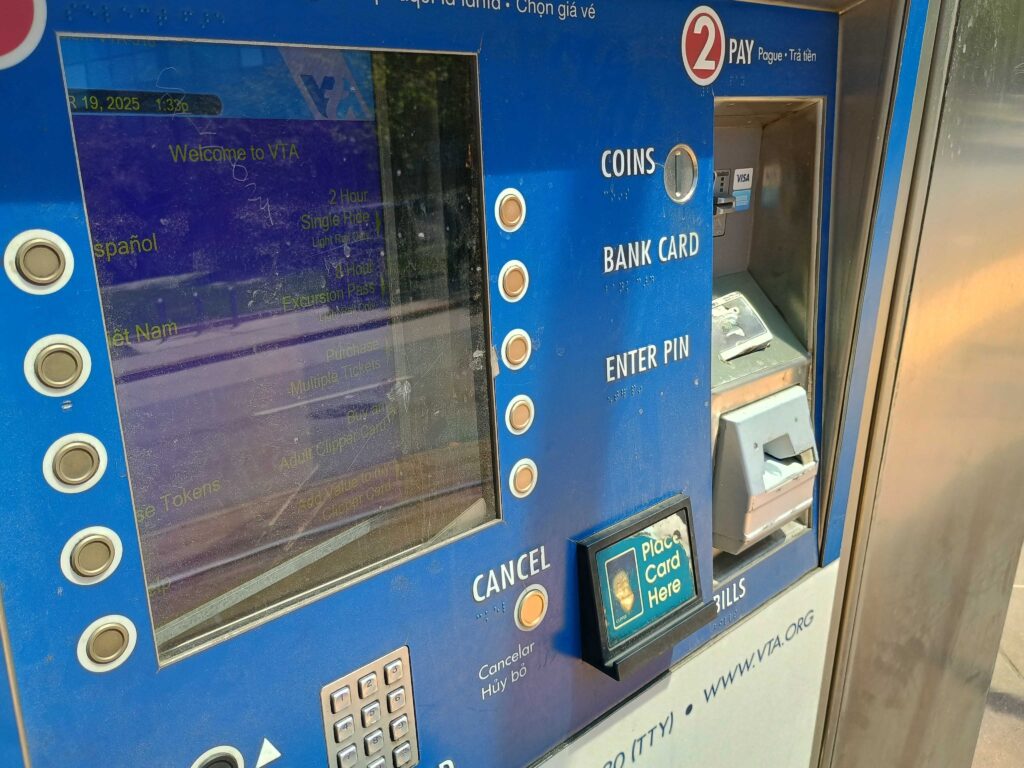By Betsy Megas:
Like many VTA riders, I occasionally reload my Clipper Card at VTA ticket machines on light rail platforms. I don’t use them all that often, so I was surprised to find that not just one, but several of the VTA ticket machines at the light rail stations I tried were broken.
A broken or stalled fare machine can be a big problem. A first-time or infrequent rider could get stuck if they arrive on a platform and can’t buy fare because the machine isn’t working. Yes, there’s an app for that, but not everyone has a working smartphone on them at all times. Broken fare machines also mean that VTA ridership is likely underreported as some people likely still board without fare.
I reported the machines to VTA for maintenance, but finding so many machines broken among the few I tried got me wondering if this is a bigger issue throughout the system, if VTA knew about it, and what VTA was doing to make sure riders have an easier time paying for and using the system. When I first asked about it, all I got back was instructions to report the machine I found broken. I still don’t know if they missed the bigger question or chose not to acknowledge it.
I thought I might get more attention if I had numbers behind my claim, so on a sunny spring Saturday, I set out on my bicycle with my Clipper Card, a Clif bar, and a clipboard. That afternoon, I biked 18 miles to visit 12 VTA light rail stations along North First Street and Tasman Drive and attempted my basic transaction at 31 machines.
The results were much worse than I expected.
Of the 12 stations I visited, five of them did not have a single machine working well enough to complete a transaction.
Looking at the 31 individual ticket machines, the situation was similarly bleak . Here’s the breakdown of how broken down the VTA ticket machines are:
While considering where to submit my findings to VTA, I attended a public meeting in person. My survey was off topic, so I waited until after the meeting to approach the staff and ask them how to proceed. I saw a VTA staffer that I knew from other volunteering I do and decided to ask him where to send my report inside VTA. As it turned out, he was exactly the right person to take on this issue!
His face fell when I showed him the numbers. He called them “distressing,” and asked me to send my results in email to him, which I did.
Since then, my entire list of machines went to the maintenance department for attention, and there seems to be a new sense of urgency. They can’t fix every dark screen, but at least they can reboot the ones that are just stalled.
At least as important, my report is making the rounds among high-level staff across VTA. They are digging into how the ticket machines got so chronically broken without getting the attention they needed, and they’re working on ways to prevent other problems from going unnoticed. Plus, VTA staff can now use these numbers to support their push for getting more resources allocated to ticket machine maintenance and upgrades.
Each of us can help make transit better when we work in partnership with VTA and the other transit agencies we use. Yes, helping our transit agencies includes telling our elected officials to fund transit and encouraging others to ride transit. It also includes helping transit agencies see where they are falling short and how they can do better.
If there is an issue you’d like to help your transit agency fix, let us know in the comments or by emailing us at info@transbaycoalition.org! Let’s work together to help improve Bay Area transit for everyone.

